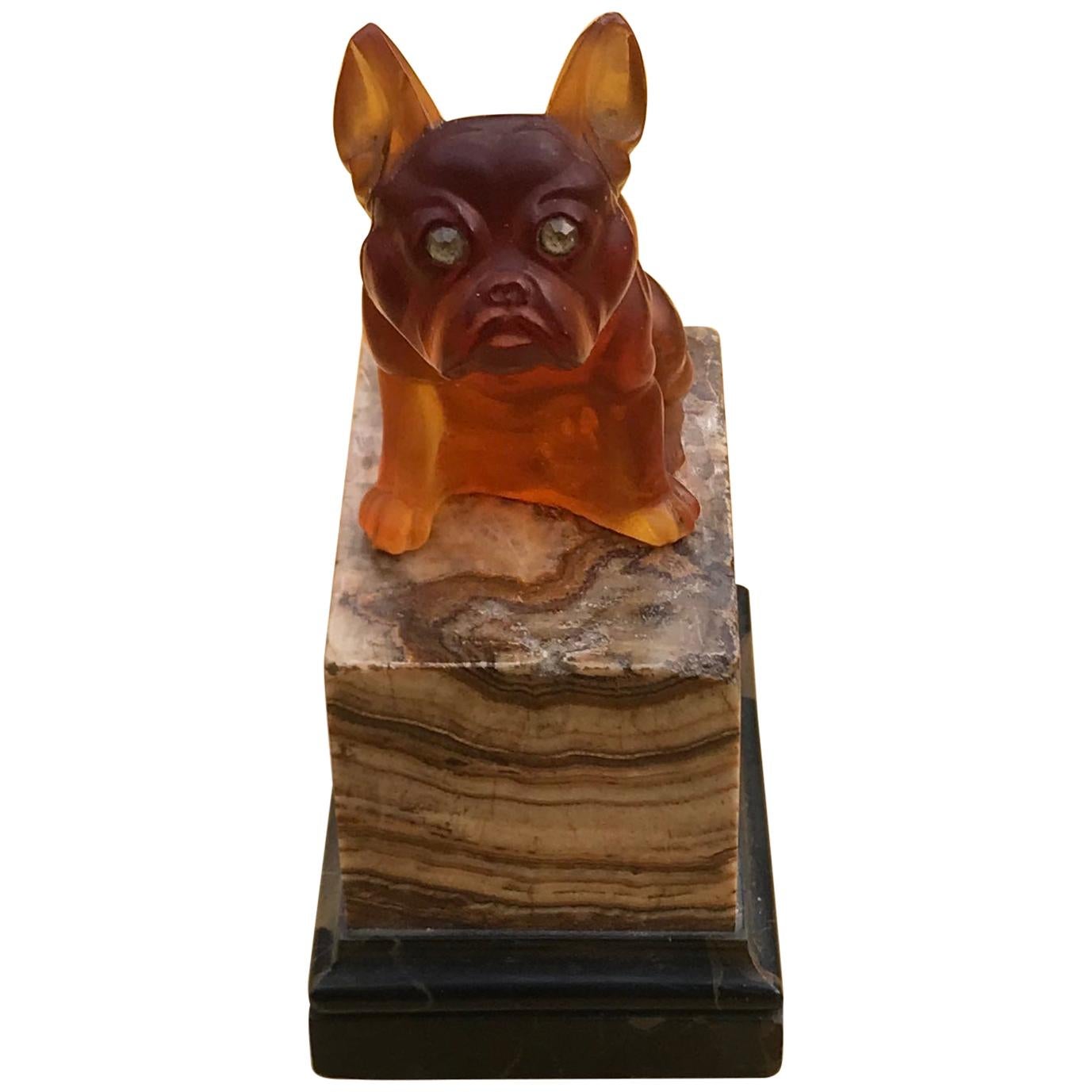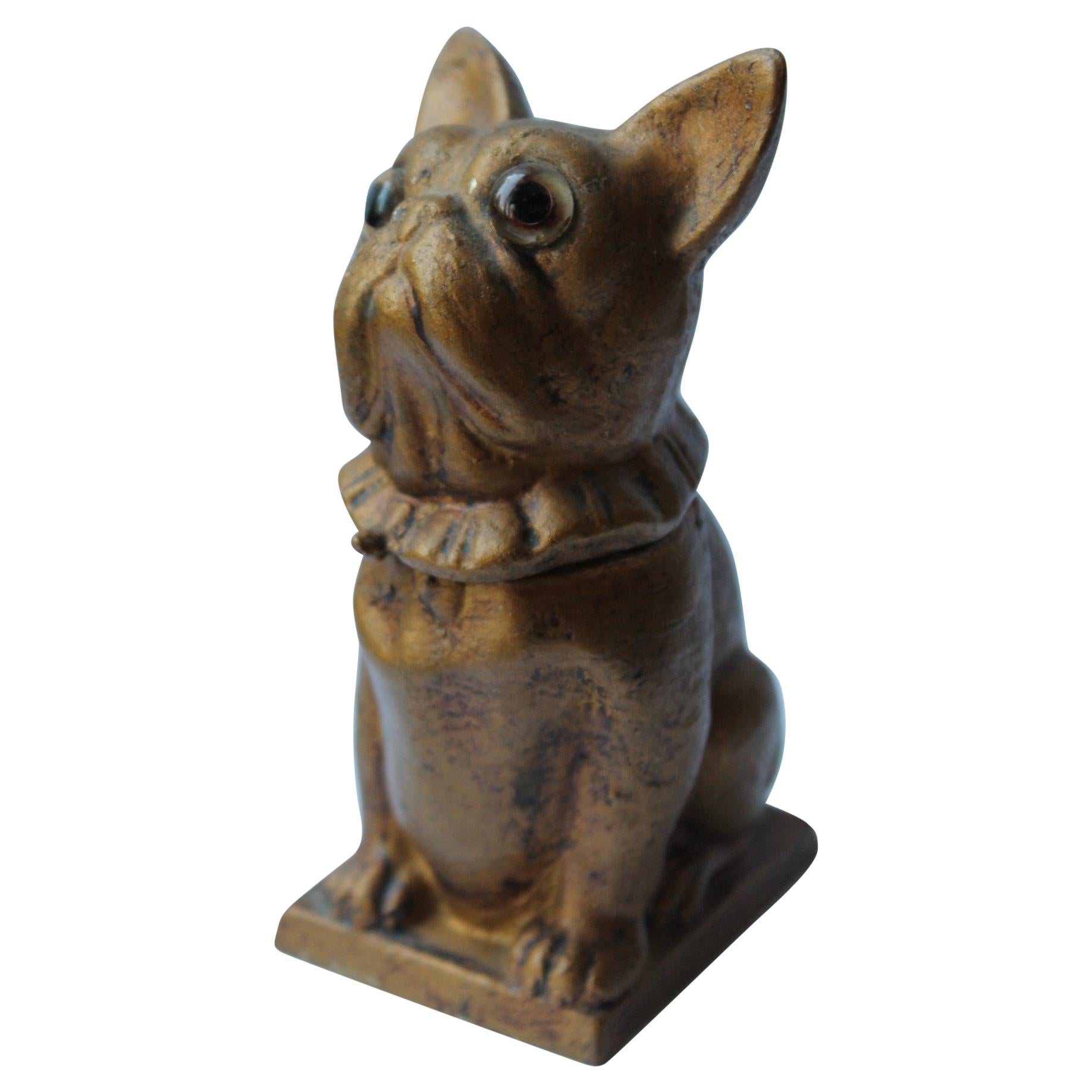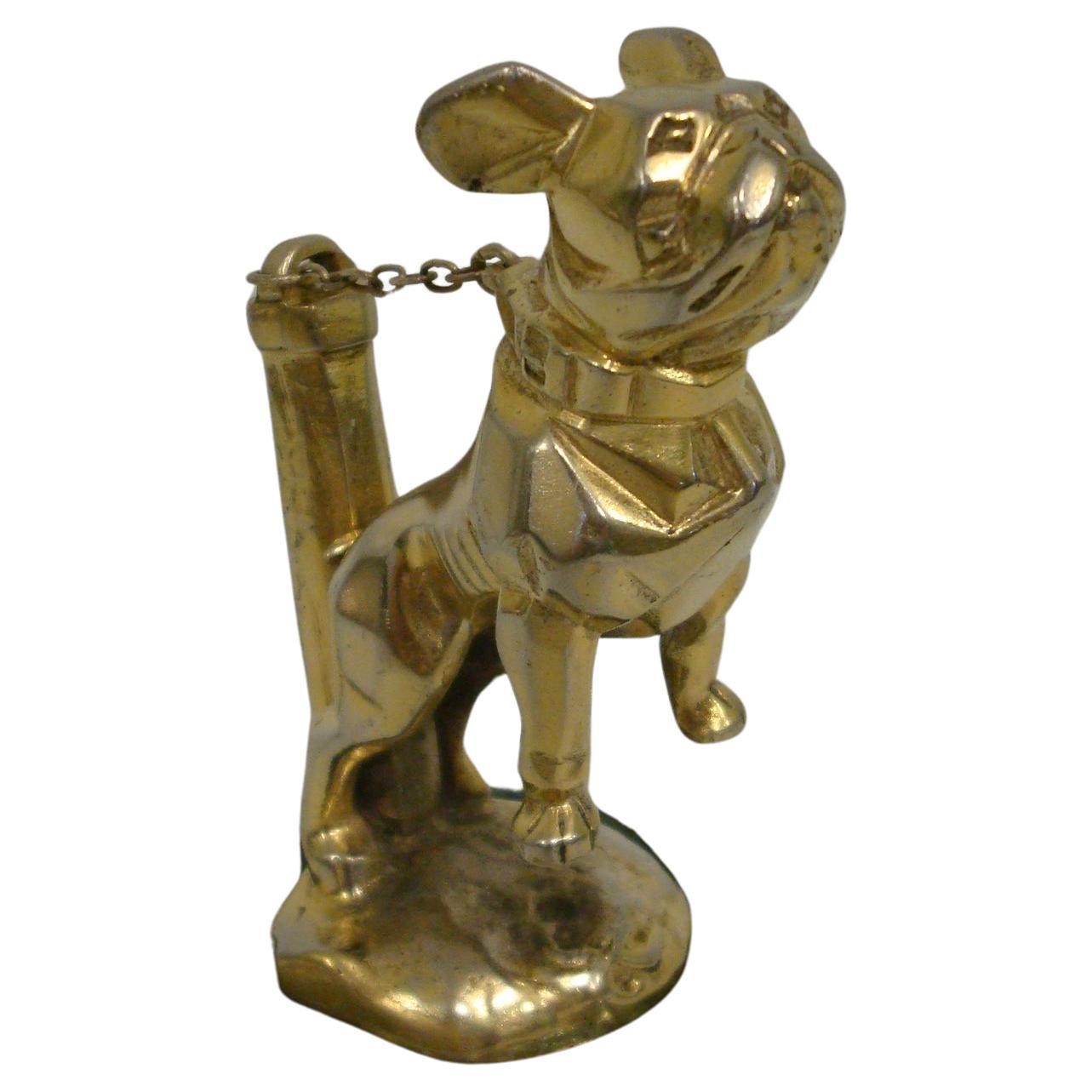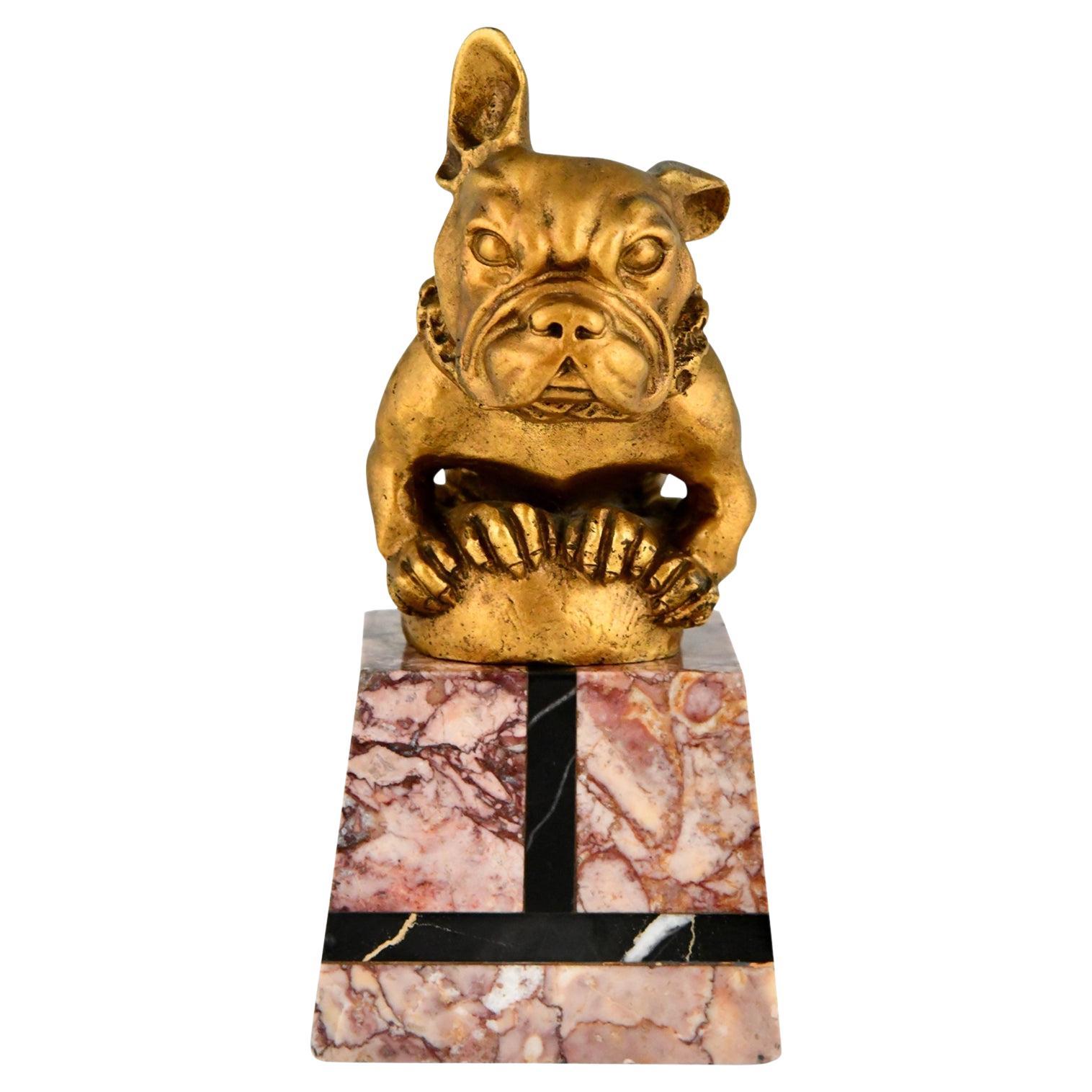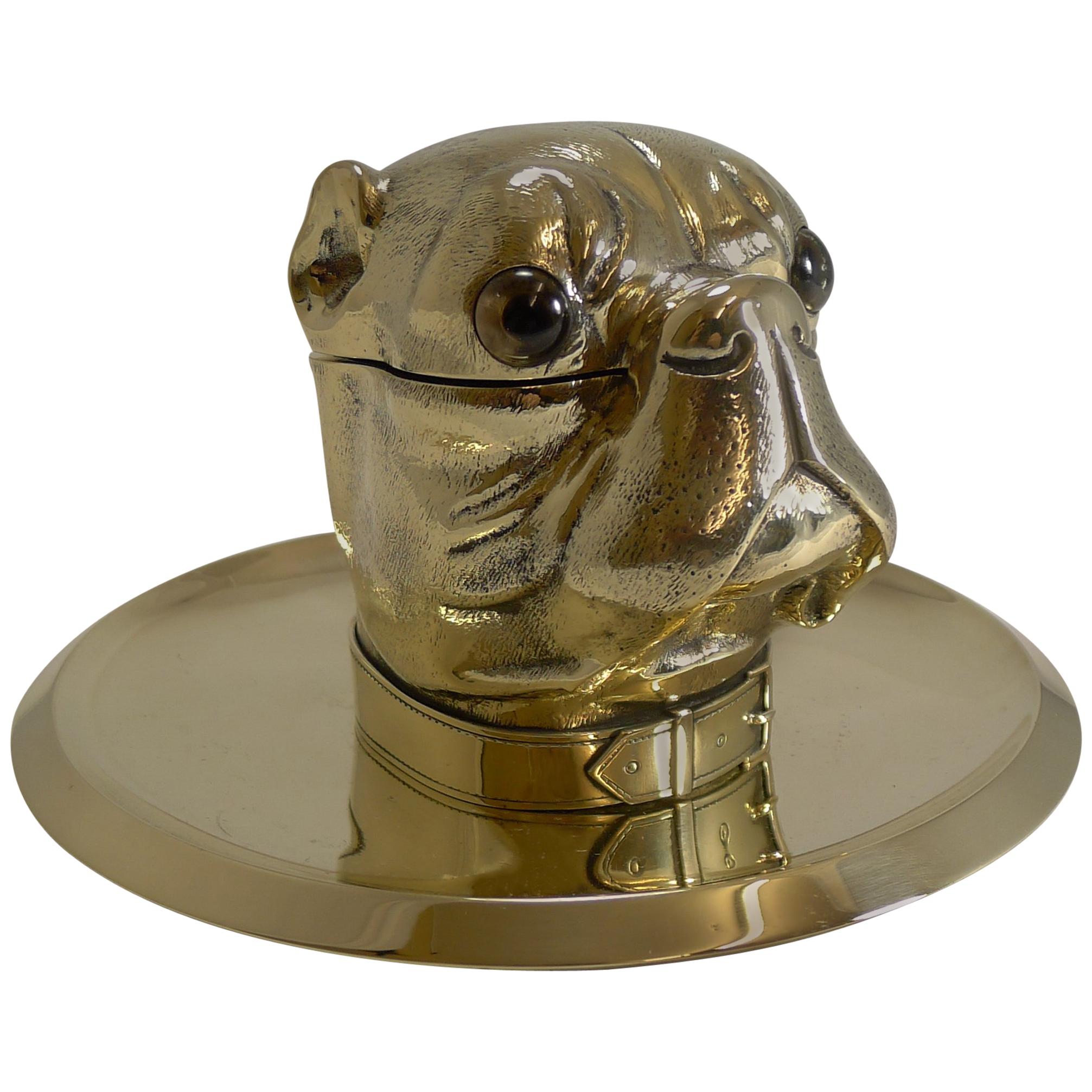Items Similar to Bulldog Cigar Ashtray, 1940, Chicago. Usa
Video Loading
Want more images or videos?
Request additional images or videos from the seller
1 of 22
Bulldog Cigar Ashtray, 1940, Chicago. Usa
About the Item
Sign: Central Die Casting & Mfg Co. Chicago- Usa
We have specialized in the sale of Art Deco and Art Nouveau and Vintage styles since 1982. If you have any questions we are at your disposal.
Pushing the button that reads 'View All From Seller'. And you can see more objects to the style for sale.
Why are there so many antiques in Argentina?
In the 1880 – 1940 there was a grate wave of immigration encouraged by the periods of war that were taking place.
1st World War took place between 1914 and 1918
2nd World War took place between 1939 and 1945
The immigrants options were New York or Buenos Aires. Tickets were cheap and in Buenos Aires they were welcomed with open arms, as it was a country where everything was still to be done.
Argentina was the country of new opportunities, labour was needed and religious freedom was assured, in many cases the of the family travel first until they were settled and then the rest of the family members join them.
In the immigrant museum “Ellis Island Immigrant Building” in New York you can se the promotional posters of the boats that would take them to a new life.
Between the years 1895 and 1896, Argentina had the highest DGP (gross domestic product) per capita in the world according to the Maddison Historical Statistics index, this situation arose due to the large amount of food being exported to European countries, which were at war.
The Argentinean ships left the port of Buenos Aires with food, but they returned with furniture, clothes and construction elements, (it´s common to see this the old buildings of the historic neighbourhood of San Telmo, the beams with the inscription “Made in England)”, as well as many markets that were built in Buenos Aires, such us the San Telmo Market, whose structure was brought by ship and afterwards assembled in 900 Defensa Street.
With the great influence of European immigrants living in the country, the children of the upper classes travelled to study in France, resulting in the inauguration of “La Maison Argentinienne”, on 27th of June 1928, in the international city of Paris, which hosted many Argentinians that were studying in Frace.
It´s the fourth house to be built after France, Canada and Belgium, being the first Spanish-speaking one. Still in place today (17 Bd Jourdan, 75014, Paris, France). Many of the children of these wealthy families who attended international art exhibitions, museums and art courses abroad, took a keen interest in the European style. This is why Buenos Aires was at the time referred as “The Paris of South America”.
Between the years 1890 and 1920 more than a hundred Palaces were built on Alvear Avenue the most exclusive avenue in Buenos Aires. Today some of these palaces have been transformed into museums, hotels and embassies.
In the year 1936, the Kavanagh building was inaugurated, it was the tallest reinforced concrete building in South America.
During 1994 the American Society of Civil Engineers distinguished it as an “international engineering milestone”, and it´s now considered a World Heritage of Modern Architecture.
At the time was common to hire foreign architects such as Le Corbusier, who visited Buenos Aires/Argentina in 1929 and in 1948 he drew up the blueprints for a house built in La Plata City (which was declared a World Heritage Site).
In 1947, the Hungarian architect Marcelo Breuer designed “Parador Ariston” in the seaside city of Mar del Plata. After an Argentinean student at Harvard University convinced him to come to Argentina. He worked on an urban development project in the Casa Amarilla, area of La Boca.
The Ukrainian architect, Vladimiro Acosta, arrives in Argentina in 1928 and worked as an architect until que moved to Brazil.
Antonio Bonet, a Spanish architect who worked with Le Corbusier in Paris, arrives in Argentina in 1937, where he carried out several architectural works and in 1938 designs the well-known BFK chair.
Andres Kálnay, of Hungarian origin, made around 120 architectural masterpieces, among which the former Munich brewery stands out, he even made the furniture’s design.
The German architect, Walter Gropius, director of the Bauhaus, lived in Argentina, where he wrote articles for “Sur” magazine and founded in Buenos Aires, an architectural firm with Franz Möller, who was also an architect, where he built two houses.
At the same time several famous designers decided to immigrate to Argentina, among them we can find the well-known French designer, Jean-Michel Frank, who arrived in the country in 1940 and also worked for the Rockefeller family.
Special pieces were made, which were sold exclusively in the country, such as the well-known German company “WMF”, who sold their products by catalogue, which were chosen by the ladies of high society in the list of wedding gifts, as well as the pieces designed by Christofle.
The Swiss sculptor Alberto Giacometti, made special pieces for Argentinean mansions.
In 1904 the first Jansen branch outside Paris was established in Buenos Aires, as the Argentinean clientele demanded a large amount of furniture, from the end of the 19th century to the mid-20th century.
In 1970, the brand Rigolleau Argentina made pieces authorised by Lalique.
The brands Maple and Thompson also set up shop in the country.
The French plastic artist, Marcel Duchamp moved to Argentina in 1918-1919.
Glass signed Gallé, Charder, Leverre, Schneider, Muller and other French firms. They were bought in flower shops and were given to ladies with beautiful floral arrangements.
Some furniture manufacturers travelled to international fairs and bough the patterns to produce the furniture in Argentina, such as the furniture firm Englander and Bonta, who bought the patterns ins Italy.
It is worth mentioning that in Argentina we have the largest community of Italians outside of Italy, as it is estimated that 70 percent of the inhabitants have at least one Italian descendant, followed by Spanish immigrants.
The most Important furniture stores in Argentina:
Comte is founded in 1934 (under the direct management of Jean Michel Frank in 1940).
Nordiska (Swedish company established in 1934).
Churba in 1960, a company that brought foreign designers to present their furniture in the country:
Denmark: (Arne Jacobsen, Finn Juhl, Bender Madsen, Ejner Larsen, Poul Kjaerholm, Hans Wegner)
Sweden: (Hans Agne Jakobsson, Gustavsberg)
United States: (Herman Miller)
Finland: (Lisa Johansson, Folke Arstrom, Tapio Wirkkala, Alvar Aalto, Timo Sarpaneva)
Swedish Factory: (Orrefors)
Italy: (Littala, Vico Magistretti, Emma Gismondi, Gae Aulenti, Angelo Mangiarotti, Elio Martinelli, Gianna Celada, Angelo Mangiarotti, Mario Bellini, Carlo Scarpa)
Finland: (Olivia Toikka)
Plata Lappas (Lappas Silver): a goldsmith shop founded in 1887 in Argentina by Alcibiades Lappas of Greek origin.
In 2019, in Argentina took place “the Art Deco world congress”, in which we participated as hosts invited by Geo Darder, founder of the Copperbridge – Foundation, in which prominent people from all over the world attended to learn about Art Deco in Argentina.
Argentina currently has more than 100 Art Deco buildings and another 90 Art Nouveau buildings throughout the city of Buenos Aires.
Argentina is a country that has not been involved in many wars, which is why it has been a refuge for works of art and antiques from different periods of time, unlike European countries. That is way many collectors, museums and antique dealers from all over the world visit it, you should not miss the opportunity to visit this great country.
Laura Guevara Kjuder, architect.
- Dimensions:Height: 4.53 in (11.5 cm)Diameter: 7.49 in (19 cm)
- Style:Art Deco (Of the Period)
- Materials and Techniques:
- Place of Origin:
- Period:
- Date of Manufacture:1940
- Condition:Wear consistent with age and use.
- Seller Location:Ciudad Autónoma Buenos Aires, AR
- Reference Number:1stDibs: LU6785235851452
About the Seller
5.0
Vetted Seller
These experienced sellers undergo a comprehensive evaluation by our team of in-house experts.
Established in 1982
1stDibs seller since 2022
21 sales on 1stDibs
Typical response time: <1 hour
- ShippingRetrieving quote...Ships From: Hollywood, FL
- Return PolicyThis item cannot be returned.
More From This SellerView All
- Horse Murano, 1930, ItalianLocated in Ciudad Autónoma Buenos Aires, CMurano We have specialized in the sale of Art Deco and Art Nouveau and Vintage styles since 1982. If you have any questions we are at your disposal. Pushing the button that reads 'V...Category
Vintage 1930s Italian Art Deco Animal Sculptures
MaterialsMurano Glass
- Couple of Murano, 1930, ItalianLocated in Ciudad Autónoma Buenos Aires, CMurano We have specialized in the sale of Art Deco and Art Nouveau and Vintage styles since 1982. If you have any questions we are at your disposal. Pushing the button that reads 'Vi...Category
Vintage 1930s Italian Art Deco Abstract Sculptures
MaterialsMurano Glass
- Dancing Couple in Murano, 1930, ItalianLocated in Ciudad Autónoma Buenos Aires, CMurano We have specialized in the sale of Art Deco and Art Nouveau and Vintage styles since 1982. If you have any questions we are at your disposal. Pushing the button that reads 'Vi...Category
Vintage 1930s Italian Art Deco Figurative Sculptures
MaterialsMurano Glass
- Ducks Murano, 1930, Italian, Sing Salviati & CBy SalviatiLocated in Ciudad Autónoma Buenos Aires, CMurano We have specialized in the sale of Art Deco and Art Nouveau and Vintage styles since 1982. If you have any questions we are at your disposal. Pushing the button that reads 'View All From Seller'. And you can see more objects to the style for sale. Salviati & C Measures: Violet : 33 long x 10 high x 5.5 depth Green: 30 long x 9 high x 5.5 depth The lawyer Antonio Salviati and his dream In 1859 in his premises at Number 731 of Dorsoduro, Venice the “Salviati Dott. Antonio fu Bartolomeo” company was established. This is when, Vicenza-born lawyer Antonio Salviati started the entrepreneurial career, moved by a passion for the precious mosaics of the Basilica of San Marco and fascinated by Murano glass art, he decided to start-up his own production of mosaics and objects in Murano glass. An ambitious and far-sighted goal pushed him along this path: to revive the fate of Murano glass production that has been fallen for decades. A challenge which finds the maximum support from two fundamental figures in the history of Murano glass: the mayor of the island, Antonio Colleoni, and the Abbot Vincenzo Zanetti, founder of the glass museum and of the first art school for glass masters. The first successes and international investments The launchpad was the “First Glassmakers’ Exhibition” in 1864 in which Salviati participated with a monumental mosaic that earns him a prize superior to the Gold Medal. The success achieved affirmed the credibility of the Company which thus started its glass production in Palazzo da Mula. The new corporate and productive reality needed investors and the lawyer started to internationalise the company by addressing the economic and financial market across the Channel. The UK immediately showed huge interest in Salviati’s mosaics – as testified by the mosaic that can be seen on the façade of the current Apple Store in Regent Street, London. It was also in London, on 21st December 1866, that the “Società Anonima per Azioni Salviati & C.” was established with the support of diplomat Sir Austen Henry Layard and historian William Drake. The new corporate set-up was further established with the purchase of a new headquarter, this time on the Riva dei Vetrai in Murano. The universal show of Paris in 1867 celebrated the relaunch project of Antonio Salviati “Venice owes a debt of gratitude to the knight Salviati in the resurgence for one of the most legitimately famous of its industries”. From Esposizione Illustrata di Parigi, 1867 pg. 275. “Venice and Italy have gain huge success in the Universal Exhibition. The resurgence of one of the city’s most famous industries is consecrated in this very occasion by the gold medal awarded by the jury to Mr Salviati […] the crowd […] is gathering around the display cases that hold those pieces of glass that are so transparent and so light as to appear like woven air, impregnated, when in their elegant forms that become rainbows of those iridescent reflections that cover them at the artist’s whim – the author of a real ray of sunshine from the beautiful and splendid Venice”. From Esposizione Illustrata di Parigi, 1867 pg. 311 The fundamental role of training in murano glass Training plays a fundamental role for the Company; attendance at the Art School was made compulsory for “[…] all the young workers of the Factory who don’t only tire themselves in manual work. This was established with the idea not only to lift their dignity and their initially limited aspirations, […] but also to improve their artistic education and thereby facilitate an improvement also in their economic situation”. Together with the art school, a free school was also set up to teach all employees to read and write. Diversification in production and made-to-measure projects In a short time, Salviati & C. diversified its production to include glasses, cups, amphoras, and vials which guaranteed the first prize in the universal exhibition for three consecutive years. Its mosaic production also flourished, being used in world-class projects: from the Houses of Parliament in London, to the Viceroy’s palace in Alessandria in Egypt, to the Opera House of Paris, including the private homes of wealthy New York personality. The entire 19th century for Salviati & C. was represented by development, success and fame in the national and international markets, and the Company became a symbol and reference point of Murano glass art throughout the world. The Salviati legacy at the turn of the century On the death of Antonio Salviati in 1890, first his three children followed one another at the helm of the company and then Maurizio Camerino, previously general manager. It was thanks to him that the decorative mosaic project of the Stanford Memorial Church in Palo Alto (California, USA) took place after 12 years of work. As well as the opening of a sales point in Via Montenapoleone in Milan and the institution of a museum collection of Murano glass from the 19th and 20th centuries. The post-war years, biennials and lighting After Maurizio Camerino’s death in 1931, his three children took over the helm of the company: its solid foundations allowed them to strive for new important goals in the art world, participating in the Biennials of 1932 and 1934. Not even the Second World War could tarnish the strength of the Salviati brand: in the post-war years Renzo Camerino renewed the ruined production headquarter and enthusiastically restored all his commercial contacts. Thanks to his grandson Renzo Tedeschi (newly graduated in Engineering at the Polytechnic of Turin and upon his return from an apprenticeship in the United States), Salviati launched its production in lighting appliances. The following years saw intense growth in the number of collaborations with renowned artists and designers. In 1959, the production site was moved to Fondamenta Radi 16, where it still stands today. The great lighting projects The larger production area allowed the company to further expand the international market in the field of architectural lighting. A number of projects were undertaken, such as the 9-tonne, 22-metres high chandelier in the Chamber of Commerce in Parma, the ceiling illumination in the premises of the World Intellectual Property Organisation in Geneva and the Kowloon Hotel in Hong Kong; not to mention the sound-absorbing windows of the Aula Nervi in the Vatican and the lighting system of the great honour hall of the Philippine Plaza Hotel in Manila in collaboration with architect John Marsteller. The reputation of Salviati & C. was further affirmed by the commission – after an international call for bids – for twelve 11-metre high chandeliers for the Tonhalle concert hall in Dusseldorf, made using an innovative system of modular glass elements – “LS- System” – one of the today company’s cornerstones. Salviati from the modern age to the present The story of Salviati continues in the modern era, keeping the focus on creating an innovative style that had distinguished it since its inception. Participation in international exhibitions increased, such as the Venice Biennials from 1958 to 1972 (the final year in which Murano glass was allowed) thanks to projects by designers of the calibre of Betha and Teff Sarasin, Claire Falkestein, and Luciano Gaspari. In 1962 Salviati was awarded with the highest recognition in the Design world, the “Compasso d’Oro” prize assigned by A.D.I. for the Marco vase designed by architect Sergio Asti. In 1965 the company changed its name to Salviati & C. s.p.a.; then it was purchased by the Gruppo Ferruzzi in 1987 which later on it was transferred to a French company. Since 2015 the company returned to be Venetian with the acquisition by the Umana group. Salviati and its designers Salviati’s designers: Luciano Gaspari, Sergio Asti (Compasso d’Oro 1962), Claire Falkenstein, Ward Bennet, Teff and Betha Sarasin, Ingo Maurer, Ross Lovegrove, Amanda Levete, Tom Dixon, Nigel Coates, Thomas Heatherwick, Luca Nichetto, Ben Gorham...Category
Vintage 1930s Italian Art Deco Animal Sculptures
MaterialsMurano Glass
- Giraffe Murano, 1930, ItalianLocated in Ciudad Autónoma Buenos Aires, CMurano We have specialized in the sale of Art Deco and Art Nouveau and Vintage styles since 1982. If you have any questions we are at your disposal. Pushing the button that reads 'Vi...Category
Vintage 1930s Italian Art Deco Animal Sculptures
MaterialsMurano Glass
- Medida :1920, Car Sculpture in wood Sign: Argentor wienBy Argentor of ViennaLocated in Ciudad Autónoma Buenos Aires, CMaterial: Wood and silver plated bronze We have specialized in the sale of Art Deco and Art Nouveau and Vintage styles since 1982. If you have any questions we are at your disposal. Pushing the button that reads 'View All From Seller'. And you can see more objects to the style for sale. Argentor wien...Category
Vintage 1920s Austrian Art Deco Mobiles and Kinetic Sculptures
MaterialsWood
You May Also Like
- Art Deco Pen Holder French Bulldog, 1940sLocated in Antwerp, BEArt Deco desk set - pen holder - paper weight - Desk Accessory with a French bulldog on top. This Animal Themed Pen Holder has a brown and white Marble Base with a bronze bulldog d...Category
Mid-20th Century European Art Deco Animal Sculptures
MaterialsMarble, Bronze
- Vintage French Bulldog on Agate BaseLocated in New York, NYVintage French bulldog on agate base. Carved crystal carnelian red French bulldog mounted on antique agate and marble base. Italy, circa 1940 Dimensions: 5....Category
Mid-20th Century Italian Animal Sculptures
MaterialsAgate, Crystal
- Art Deco Bulldog Still Bank, Money Bank, Gold Painted MetalLocated in Antwerp, BECute Gold Painted Metal Bulldog Money Bank . This Moneybox Bulldog Dog Figurine has Big Eyes which are looking into yours, so you can't say no to him. It's a Detailed Bulldog Figuri...Category
Early 20th Century European Art Deco Animal Sculptures
MaterialsMetal
- Art Deco Car Mascot, Chained French Bulldog, Hood Ornament, France 1920sLocated in Buenos Aires, OlivosArt Deco 'Chained Bulldog' Car Mascot / Hood Ornament designed by Marvel, French, 1920´s, silver-Gilt plated bronze, small version, 14cm long, compl...Category
Vintage 1920s French Art Deco Animal Sculptures
MaterialsBronze
- Art Deco Bronze Car Mascot French Bulldog Signed by Gaston H. Bourcart, 1925By E. BourcartLocated in Antwerp, BEArt Deco bronze car mascot French bulldog signed by Gaston H. Bourcart. The hood ornament is in gilt bronze and stands on a marble base. France 1925. This mascot is illustrated plate nr. 329 Mascottes passion, Michel Legrand, Antic show éditions. More information: Mascottes automobiles...Category
Vintage 1920s French Art Deco Animal Sculptures
MaterialsMarble, Bronze
- Grand English Bulldog Novelty Inkwell with Glass Eyes, circa 1880Located in Bath, GBA magnificent English Victorian inkwell made from solid English brass having been professionally polished to gleam. This grand figural dog inkwell was modelled in the form of an E...Category
Antique 1890s English Late Victorian Inkwells
MaterialsBrass
Recently Viewed
View AllMore Ways To Browse
19th Century Danish Still Life
Promotional Chair
Alvar Aalto War
Comte Jean Frank
Michel Herman
Aalto Childrens Chair
Antique Hungarian Chair
Dealer Ashtray
Religious Articles
Vintage Miss Dior
Ashtrays French Bulldog
Carving Station
Randy Stromsoe Teapot
Modernist Table Sculpture
Kzeng Jiang
Juan Carlos Navarro
Tramonti Guerrino
Kramer Mid Century Ceramic Pottery

